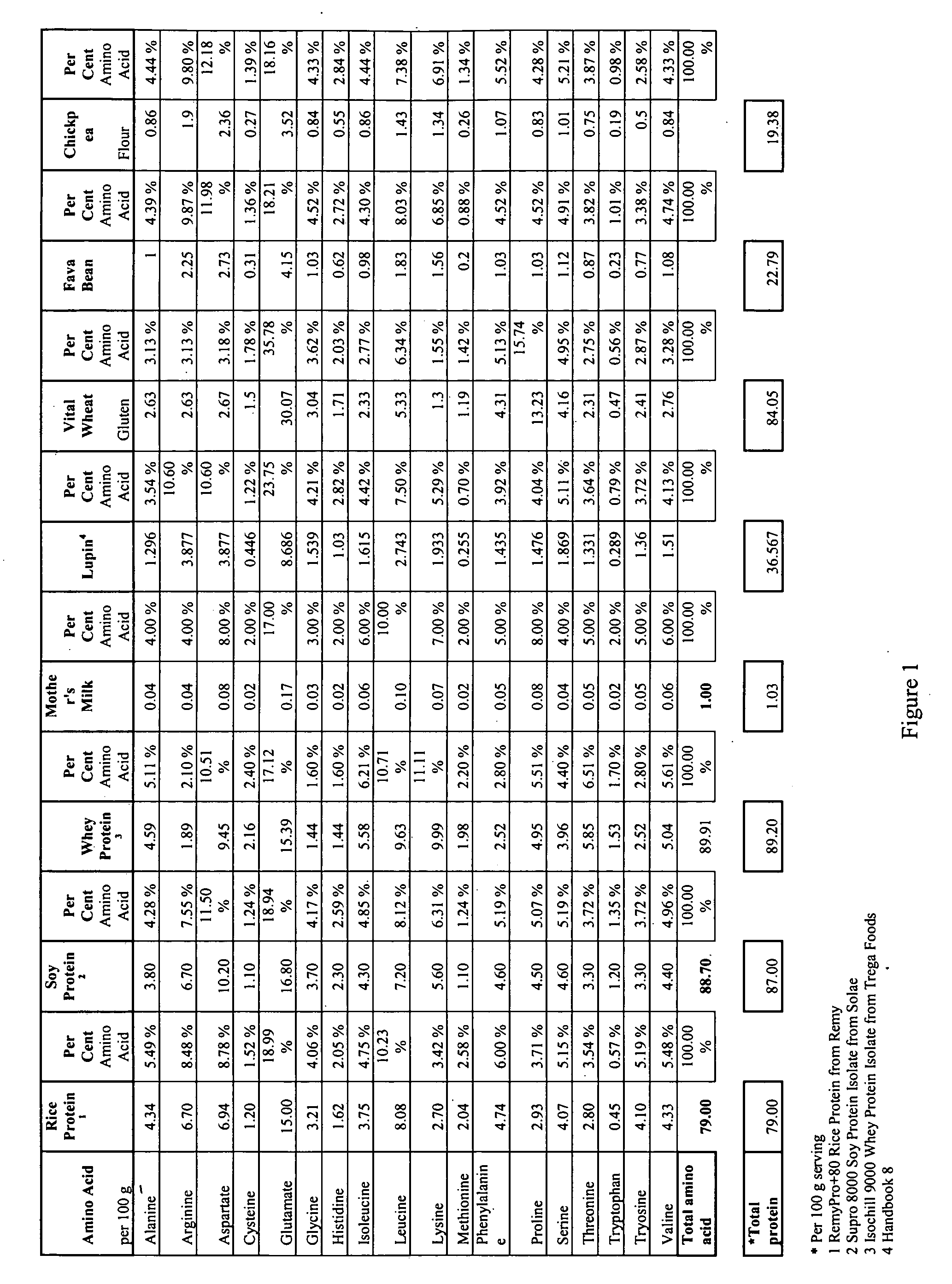Textured food product
a food product and texture technology, applied in the field of texture food products, can solve the problems of unresolved problems, difficult extrusion of whey proteins, and a very allergenic food, and achieve the effect of low rancidity and low flavor
- Summary
- Abstract
- Description
- Claims
- Application Information
AI Technical Summary
Problems solved by technology
Method used
Image
Examples
example 1
Rice Protein Concentrate
[0102] RemyPro 80+ was provided in separate batches, before and after alterations to the development designed to improve the flavor of the rice protein ingredient, in particular, to remove a bitter off flavor. The batches before and after the process modifications are designated “old” and “new”, respectively
[0103] Head space analysis was conducted the old and new RemyPro 80+ rice protein ingredients. Measurements of the hexanal concentration from head space volatiles was performed in accordance with procedures known to the art. The protein processed with the old process had a head space hexanal value up to 18300 ppb. The protein processed with the new process had a head space hexanal value up to 7510 ppb.
example 2
Extrusion of Textured Rice Protein Product
[0104] Textured rice protein products were made according to the present invention by extruding a raw mix rice protein concentrate and the additional ingredients described for Table 1, below. The admixture was produced using sufficient water to make a stiff dough, at an approximate ratio of 1 part water to 1.5-4 parts dry ingredients.
[0105] Extrusion was conducted using a Buhler twin screw extruder. In the Buhler twin screw extruder, dry feed and liquid are added separately and mixed in the barrel. The admixture was extruded through a die and the pieces were dried.
[0106] Extrusion parameters were: screw speed of 1500-2500 rpm, product temperature at the die of >180.degree. F., feed rate of 600-800 lb / hour, and water-flow rate of 180-400 lb / hour. Observations were made on color, opacity, structure, and texture for each collected sample. Collected samples were dried at room temperature overnight.
[0107] Table 1 lists provides information on...
example 3
Hedonic Test
[0108] Tests on the various products were made with trained tasters, using a hedonic system on a scale of 1 to 10, level 1 being least palatable, and level 10 being the most palatable.
TABLE 2Rice ProteinconcentrateTester 1Tester 1Tester 1Tester 2Tester 2Tester 2Avg overallProductor isolateFlavorShapeOverallFlavorShapeOverallscoreR-371CNP 50%6248886ProR-431RemyPro5552823.570+R-490RemyPro433623380+ (old)R-500RemyPro343283380+ (old)R-521RemyPro333723380+ (old)R-524RemyPro444622380+ (old)R-564RemyPro3533743.580+ (old)R-565RemyPro3432722.580+ (old)R-566RemyPro464364480+ (old)R-659RemyPro4549654.580+ (new)R-667RemyPro6765876.580+ (new)R-671RemyPro767989880+ (new)R-673RemyPro544856580+ (new)R-677RemyPro7778887.580+ (new)
PUM
| Property | Measurement | Unit |
|---|---|---|
| density | aaaaa | aaaaa |
| density | aaaaa | aaaaa |
| density | aaaaa | aaaaa |
Abstract
Description
Claims
Application Information
 Login to View More
Login to View More - R&D
- Intellectual Property
- Life Sciences
- Materials
- Tech Scout
- Unparalleled Data Quality
- Higher Quality Content
- 60% Fewer Hallucinations
Browse by: Latest US Patents, China's latest patents, Technical Efficacy Thesaurus, Application Domain, Technology Topic, Popular Technical Reports.
© 2025 PatSnap. All rights reserved.Legal|Privacy policy|Modern Slavery Act Transparency Statement|Sitemap|About US| Contact US: help@patsnap.com

